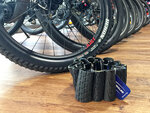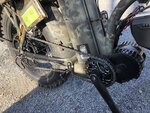Hi guys! I'm moving some content off of the main site and into the most relevant categories of the forum. This post was originally made on February 6th 2018:
Electric bikes tend to be heavier than traditional bicycles because they have batteries, motors, additional wires, and often sturdier frame. The added weight, higher average speeds of operation, and increased use leads to more wear and exposure for tires and inner tubes. Furthermore, the process of changing flat tubes is made difficult by the heavier frame weight, wires, torque arms, and bolts used to secure the drive systems. For these reasons, tire quality plays a more important role in the use and enjoyment of electric bikes. Tires with puncture protection will require less frequent maintenance, tires with reflective sidewall graphics will keep you more visible when riding at higher speeds and in traffic. In the following video, we explore different types of tires and compare what comes stock on many ebikes to what is available aftermarket.
Tires are one consideration for ebikes, but wheel size is also a factor. Depending on the intended use, you might have 16″, 20″, or 24″ wheels for folding, cargo, kid, and small bike frames. From here, a very common size is 26″ for lower city and neighborhood models and then on up to the most classic 700c or 28″ wheel size. The larger the wheel diameter, the more efficiently it can coast but the slower it will turn. Larger wheels tend to weigh more, unless they have narrow high-pressure tubes and tires. This is what you often see on road bikes… A larger wheel diameter will lower the attack angle of the tire, allowing it to span across cracks and ease up bumps vs. falling in or jarring up. There are many factors to consider and appreciate when it comes to wheel size and tire type. Below are a few interesting examples:

This written guide only skims the surface of what wheel size, tire type, and inner tubes can do to enhance ride experience. You can even run some tires without inner tubes to achieve lighter weight and lower pressure. I welcome your questions and feedback below in the comments, or you can connect directly with other owners and enthusiasts in the forums. Before you choose an electric bike, consider the cost of time and effort that flat tires can cause. Consider the difference in price between a higher quality ebike with nicer components and tires vs. one that looks similar but might not handle your ride conditions as well. You can usually find suitable upgrades and replacement tires aftermarket, and it’s something that your shop can help with. Make sure you look at the sidewall of the tires on your bike for a stamp that lists the sizing (often times there will be a standard measurement in inches and possibly a European measurement such as 700x38c).
Electric bikes tend to be heavier than traditional bicycles because they have batteries, motors, additional wires, and often sturdier frame. The added weight, higher average speeds of operation, and increased use leads to more wear and exposure for tires and inner tubes. Furthermore, the process of changing flat tubes is made difficult by the heavier frame weight, wires, torque arms, and bolts used to secure the drive systems. For these reasons, tire quality plays a more important role in the use and enjoyment of electric bikes. Tires with puncture protection will require less frequent maintenance, tires with reflective sidewall graphics will keep you more visible when riding at higher speeds and in traffic. In the following video, we explore different types of tires and compare what comes stock on many ebikes to what is available aftermarket.
Tires are one consideration for ebikes, but wheel size is also a factor. Depending on the intended use, you might have 16″, 20″, or 24″ wheels for folding, cargo, kid, and small bike frames. From here, a very common size is 26″ for lower city and neighborhood models and then on up to the most classic 700c or 28″ wheel size. The larger the wheel diameter, the more efficiently it can coast but the slower it will turn. Larger wheels tend to weigh more, unless they have narrow high-pressure tubes and tires. This is what you often see on road bikes… A larger wheel diameter will lower the attack angle of the tire, allowing it to span across cracks and ease up bumps vs. falling in or jarring up. There are many factors to consider and appreciate when it comes to wheel size and tire type. Below are a few interesting examples:
- Folding ebikes tend to use smaller 20″ wheel sizes because they lower the frame and take up less space when the bike has been folded, in order to give you full leg extension and a comfortable upright fit they will use longer seat posts and stems. Most tires are 20″ x 1.75″ but some have opted for wider 2″ tires to improve stability and comfort… there are even fat tire folding ebikes now! The added weight and friction of fat tires is overcome by electric assist motors, you can see this on the RadMini ebike
- Full sized fat tires are one thing, but there is a new standard called “Plus Sized” which means tires that are 2.6″, 2.8″, or 3.0″ wide… not as narrow as traditional tires, but not quite fat. Plus sized tires have become popular on mountain bikes and even some city bikes that seek improved comfort and stability like the Tern GSD mini-cargo bike, which uses 2.4″ width tires that aren’t quite plus sized but are definitely larger than most 20″ tires. One big consideration in using plus sized tires is how wide the fork and rear dropout area of the bike is, many bikes have to widen their hub spacing from 100 mm in the front to 110 mm to work with plus sized tires and from 135 mm to 148 mm in the rear, this increases the spoke angle and provides the necessary strength and space for the larger, heavier tires
- In recent years, mountain bikes have evolved from using 26″ diameter tires up to 29″ and then back down to 27.5″ as a compromise. You can still find bikes with all three sizes, and the difference is in how high the bike frame is elevated, the clearance between the tire and frame (when using suspension), how light and twitchy steering will be (moreso with the smaller diameter), and whether you can decrease deflection and increase float with greater surface area and air volume. Often times, 29″ wheels are used for cross country riding and 27.5″ is used for all mountain – sometimes accompanied by plus sized tires. You can see this on the full suspension Bulls E-Stream EVO AM 4
- Electric cargo bikes will sometimes opt for two different wheel sizes in order to bring the cargo bay closer to the ground, while preserving comfort and gearing ratios. Front loader bikes will usually opt for a smaller 20″ wheel in the front while rear rack bikes will use a smaller 24″ or 20″ wheel in the back… As long as both tires keep their tread and the inner tube is not flat, this is a great setup for riding, but it does add some complexity and expense when purchasing replacements because each wheel setup is unique. You cannot just buy two of the same tubes and tires.

This written guide only skims the surface of what wheel size, tire type, and inner tubes can do to enhance ride experience. You can even run some tires without inner tubes to achieve lighter weight and lower pressure. I welcome your questions and feedback below in the comments, or you can connect directly with other owners and enthusiasts in the forums. Before you choose an electric bike, consider the cost of time and effort that flat tires can cause. Consider the difference in price between a higher quality ebike with nicer components and tires vs. one that looks similar but might not handle your ride conditions as well. You can usually find suitable upgrades and replacement tires aftermarket, and it’s something that your shop can help with. Make sure you look at the sidewall of the tires on your bike for a stamp that lists the sizing (often times there will be a standard measurement in inches and possibly a European measurement such as 700x38c).


